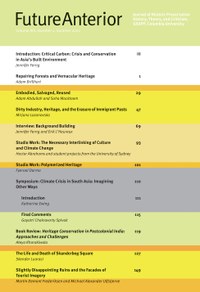Future Anterior
Columbia University Graduate School of Architecture, Planning and Preservation

CALL FOR PAPERS:
Special issue: Critical Carbon: Rethinking Energy and Heritage in the Asia Pacific
Guest editor: Jennifer Ferng, The University of Sydney
Manuscripts due: Jan. 31, 2023
Download the Call for Papers PDF for details.
Future Anterior approaches historic preservation from a position of critical inquiry, rigorous scholarship, and theoretical analysis. The journal is an important international forum for the critical examination of historic preservation, spurring challenges of its assumptions, goals, methods, and results. As the first journal in American academia devoted to the study and advancement of historic preservation, it provides a much-needed bridge between architecture and history.
The journal also features provocative theoretical reflections on historic preservation from the point of view of art, philosophy, law, geography, archeology, planning materials science, cultural anthropology, and conservation.
Future Anterior is essential reading for anyone interested in historic preservation and its role in current cultural debates. Click here for an index to the contents of past issues.
For a full list of present and past issues and the associated table of contents, please see the Future Anterior page on Project MUSE.
To check the availability of back issues and to place a single copy order, please email journals@umn.edu.
-------